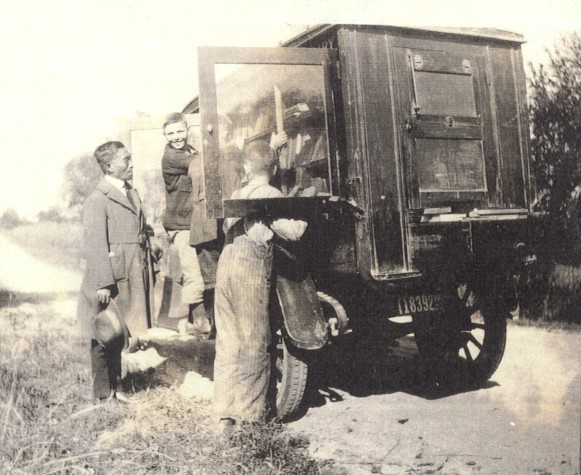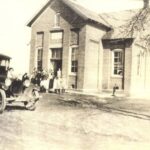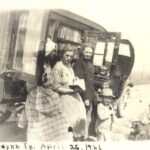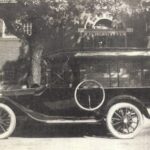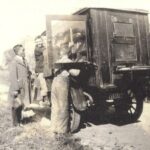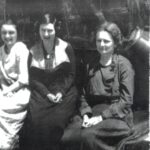Hamilton County’s First Bookmobile
By: David Heighway, Hamilton County Historian
In 1920, Noblesville Library director Lulu Miesse was looking for ways to further expand the library service. The townships of White River, Wayne, and Fall Creek had become part of the library district in 1919. Miss Miesse realized that for many of the farmers in the outlying townships, a trip to town was a rare event, and a detour to the library was even rarer. Putting small libraries in the one-room schoolhouses had met with only moderate success. Then she heard about some libraries that had put books aboard a truck and were traveling to the patrons. In her typical methodical fashion, she visited other libraries – such as Logansport, Gas City, and Elkhart – and examined their vehicles to see what worked the best. She took photographs of the various constructions, compared prices, and then analyzed the needs of Hamilton County patrons.
In the end, she decided on a kind of truck called a Dodge Brothers Commercial Car. The Dodge brothers had made ambulances for World War I and their vehicles were renowned for their ruggedness. She purchased the car in July of 1920 from W. Hare & Sons for $1,260. It was then sent to a local lumber company for $223.85 worth of bodywork, bookcase construction, and lettering. It began making trips in the fall and by spring she had sixteen routes set up. She brought in two other women to be drivers, Jeanette Williamson and Esther Heinzmann.
The Dodge Brothers Company heard about this unique use of one of their vehicles and wrote to Miss Miesse in January of 1921 asking for information that they could use in their advertising. She sent them an essay complementing them on its ruggedness since she traveled to some homes and schools that were well off the beaten path. She told the Dodge Company that the truck had been given the name “Parnassus”. This came from a novel called Parnassus on Wheels about an itinerant book salesman. The novel was written by Christopher Morley, who sent the library a note of thanks when he was told about it. The name “Parnassus” is a reference to a mountain in Greece that in classical times was believed to be the home of the muses.
Dodge Brothers took this essay and put it into newspapers and magazines all over the United States. Miss Miesse was inundated with requests for information. The Director of the National Library of the Philippines was visiting Indiana at that time and went along for a ride. “Book wagons” were a new concept and librarians from places like Kansas City, Birmingham (Ala.), Washington, D.C. and the National Library of Wales wanted to know how to start similar programs. Miss Miesse answered their letters and then collected her information into a report, which she gave at the District Library meeting in Noblesville in May of 1921. It was reprinted in the July issue of Library Occurrent. She wrote about how pleased people were to get books. She also spoke about the benefits to the librarians. They were able to get out into the country and enjoy the scenery. This also gave them an opportunity to get out of the library and meet the patrons at their homes. These meetings helped to show particular needs and concerns.
Unfortunately, one of the big concerns was taxes. Some landowners in the other townships were objecting to the amount of money this was costing them. In September of 1921, several citizens of White River Township protested against a tax levy that included the bookmobile, which they claimed was used by only ten percent of the township. Then they went further and said that they wanted to withdraw from the library district. It was pointed out that this was couldn’t be done while many people in the township had library books checked out. So a group of township men went from house to house collecting every book and early one morning, dumped them on the doorstep of the library building. Despite Miss Miesse’s best efforts, the support of libraries from around the state, and some support from the Statehouse in Indianapolis, the county voted down the tax levy in November. The route of “Parnassus” was limited to just Noblesville Township. Part of this hostility came from the hard times that had descended on the county. The natural gas boom had failed in Hamilton County and the population was declining rapidly. Between 1900 and 1930, the county lost around 20% of its population.
The library had to adjust as everyone else did when the Great Depression began. The bookmobile “Parnassus” stopped doing its book runs completely in 1931 and was sold to a local farmer in October of 1932 to be used as a fruit and vegetable truck. This was the end of bookmobile service for forty-eight years. In 1980, bookmobile service was restarted. A Chevrolet van was purchased from Hare Chevrolet and nicknamed the “Knowmobile.” After twenty years, the Knowmobile finally gave out, and a new van was purchased followed by the present van fifteen years later.
